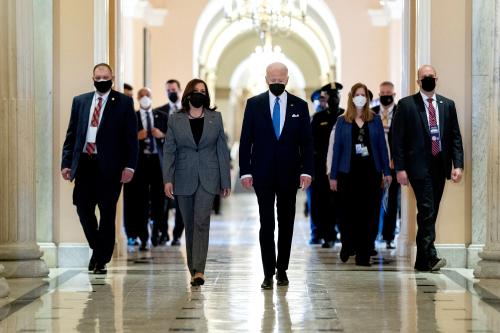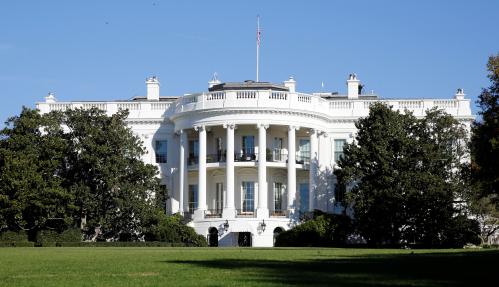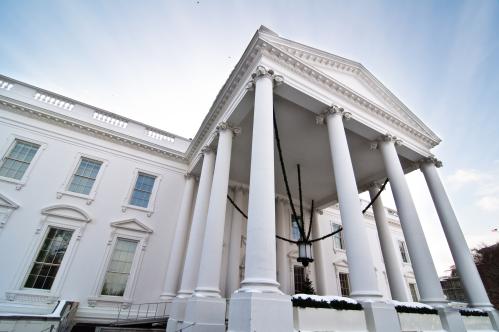Last month, Kirstjen Nielsen, the former secretary of the Department of Homeland Security, became the 15th Cabinet member to leave the Trump administration. By contrast, after three full years in office, President Obama had lost seven Cabinet members and President W. Bush had lost only four. Just as with the rate of White House staff turnover, President Trump’s level of Cabinet turnover is off the charts. But how does this turnover compare to other administrations of the past?
In an effort to provide more historical context for this trend, we recently decided to expand the Cabinet-level section of Brookings’s White House Turnover Tracker to include the Reagan and Bush administrations. This seemingly straightforward addition of a small amount of data seemed eminently manageable. In short order, however, we encountered challenges in our effort to define the composition of each president’s Cabinet. The problem arose not from the 15 Cabinet secretaries in the line of presidential succession, but in identifying the extraneous positions deemed Cabinet-level by each administration—positions like the administrator of the Environmental Protection Agency or the director of the Office of Management and Budget.
Collecting a list of these Cabinet positions revealed that there was a great deal of variance across a number of authoritative sources. For instance, the Government Printing Office’s own U.S. Government Manual (the “official handbook of the U.S. Government”), an exhaustive article from the The New York Times, and even the presidential libraries themselves consistently offered up different listings for the same administrations. Purported to be a definitive resource for factual government data, we were startled to find that multiple editions of the U.S. Government Manual were riddled with errors. For example, the 2001 edition incorrectly listed appointees from the Clinton administration, even though George W. Bush was president. The manuals even directly contradicted The New York Times’s effort to list the Cabinet members: The manual omitted the director of the Office of National Drug Control Policy while The New York Times included it.
Undaunted, we phoned presidential libraries, asking archivists for official listings of the president’s cabinet. These too were wildly contradictory to the U.S. Government Manual, muddying the waters further. Impressively, our list from the Clinton Presidential Library managed to differ from both The New York Times tracker and the manuals (nobody seems to know whether the position of FEMA director was granted Cabinet-level status). We even went so far as to ask a former White House Deputy Chief of Staff to clarify whether his boss had Cabinet status. He replied affirmatively, again contradicting our other “authoritative” sources.
These contradictions surprised us; indeed, many Americans might be surprised to learn that there is no definitive record of the positions included in each presidential Cabinet.
In search of an explanation for these discrepancies, we learned that the practice of elevating executive branch jobs to Cabinet-level positions began with President Eisenhower. According to political scientist Ronald Moe, “This special status is not recognized in law and is purely a presidential distinction that can be given and later withdrawn.” Fresh from election victory in 1952, Eisenhower appointed a helpful campaign aide and former U.S. Senator, Henry Cabot Lodge, Jr., to be the U.S. ambassador to the United Nations and a Cabinet member.
These ad hoc appointments (or “ersatz Cabinet members,” as my Brookings colleague Stephen Hess calls them), have become par for the course and can change across—or even within—administrations. After all, there are many possible reasons to elevate positions to the Cabinet: Such an appointment might aid an effort to curry favor with a key constituency, serve as a means of cajoling an individual to join the administration, or help highlight a presidential priority. In addition, these appointments can also be temporary, complicating the efforts of even the most conscientious researcher. Most recently, President Trump elevated the U.N. representative to the Cabinet, but after the departure of Nikki Haley, the position once again lost its Cabinet-level status.
Given the vagaries of Cabinet composition, we have created a new set of Cabinet turnover data that only includes those positions that are in the line of presidential succession (13 beginning with President Reagan, 14 with the addition of the Department of Veterans Affairs in 1989, and 15 with the addition of the Department of Homeland Security in 2003) and excludes other Cabinet-level appointees. We think that this research refinement provides an improved, standardized approach to analyzing Cabinet turnover. Looking at the data with our revised methodology, President W. Bush lost two Cabinet members in his first three years, President Obama lost three, and–three months into his third year—President Trump has lost eight cabinet members. Turnover in the Trump administration remains record setting, no matter how you slice the data.
Kobi Hackenburg contributed to this post.







Commentary
Who is in the president’s Cabinet?
May 21, 2019